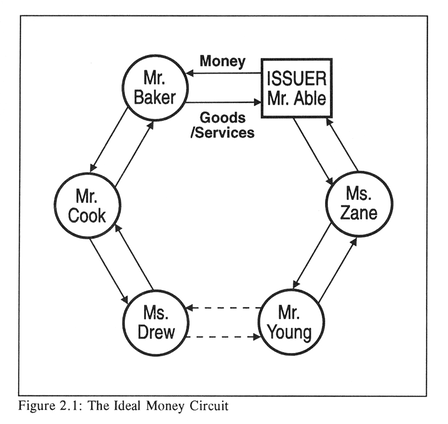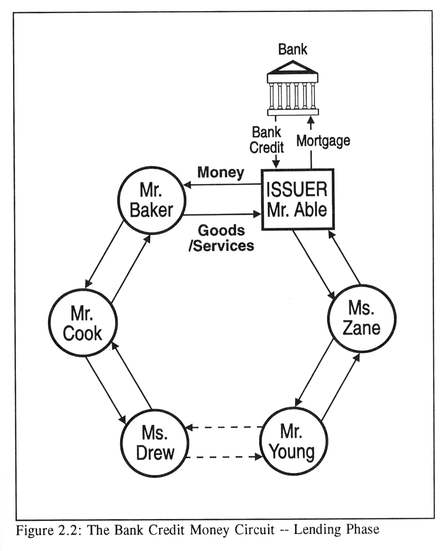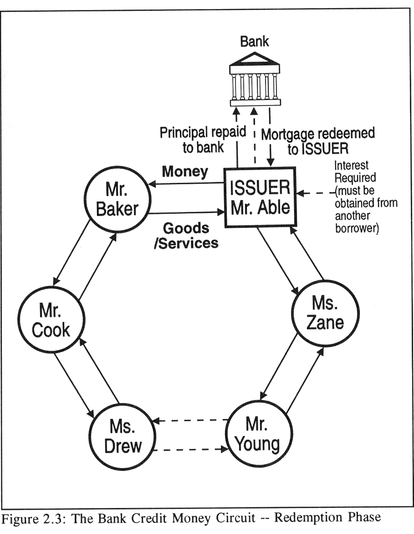-- Michael Linton
The Essential Nature of Money
- Definitions
The question, "What is money?" may seem trivial to us, who in this modern day make constant use of it, but it is confusion about the essence of money which has allowed it to be abused and misallocated. Money in classical economics is defined as (1) a medium of exchange, (2) a standard of value, (3) a unit of account, (4) a store of value, and (5) a standard of deferred payment. There are many problems with these definitions, but their primary inadequacy is that they are functional definitions; they tell what money does, not what it is. We need to understand the basic essence of money. Once we have grasped its essence we can begin to design exchange systems which will equitably serve the needs of people and the Earth.
The process of economic exchange always involves two parties. The fundamental exchange process is the barter exchange. When Smith delivers to Jones a sack of flour and Jones gives to Smith a bushel of apples in return, a complete barter transaction has occurred. Both parties are satisfied, and both have profited from the exchange. The problem with simple barter, of course, is that Jones may want Smith's flour, but he may have nothing that Smith wants. In that case no trade can be made. The fundamental purpose of money is to transcend this limitation of barter. Bilgram and Levy assert that:
"We should ... define money as any medium of exchange adapted or designed to meet the inadequacy of the method of exchanging things by simple barter. Anything that accomplishes this object is 'Money.'" [5]
So money is a "medium of exchange" which transcends the limitations of barter exchange. But what constitutes a medium of exchange, and how can one trading partner get what he wants, even though he has nothing wanted by the other? Bilgram and Levy go on to explain:
"The one quality which is peculiar to money alone is its general acceptability in the market and in the discharge of debts. How does money acquire this specific quality? It is manifestly due solely to a consensus of the members of the community to accept certain valuable things, such as coin and certain forms of credit, as mediums of exchange." [6]
We can see then that the essence of money is an agreement (consensus) to accept something which in itself may have no fundamental utility to us, but which we are assured can be exchanged in the market for something that does.
Michael Linton, the originator of an exchange system called "LETS" (Local Employment and Trading System), has provided us with an essential definition of money. Linton defines money as "an information system we use to deploy human effort." [7] This is a profound revelation and if we think about it, it becomes clear that our acceptance of money is based upon its informational content.
Whatever we use as money, then, carries information. The possession of money, in whatever form, gives the holder a claim against the community of traders. The legitimacy of that claim needs to be assured in some way. The possession of money should be evidence that the holder has delivered value to someone in the community, and therefore has a right to receive like value in return, or that the holder has received it, by gift or other transfer, from someone else who has delivered value.
Historical Forms of Money
Historically, many different forms of money have been used. But the forms of money in common use have, over time, become progressively less substantial and more ethereal. In earlier times, certain useful commodities were used as money. These included such things as salt, cattle, grain, and tobacco. Tobacco was a common form of money in colonial America. Commodity money carries value within itself making it easy for traders to evaluate its soundness. The use of commodities as a medium of exchange really amounts to indirect barter. Such commodities can serve the exchange function because they are useful in themselves and generally in demand. I may have no use for tobacco myself, but if I know that it can be easily traded, I may accept it in payment when I sell my goods or services.
The use of precious metals as money is no different in nature from the use of any other commodities. Gold and silver came to be widely used as money because they provided the advantages of greater convenience and durability, especially when stamped into coins of certified weight and fineness.
Later, it became more common to use paper notes and base metal coins which were symbolic representations of commodity money, typically gold or silver, and could be delivered to the issuer who would exchange them for the metal they represented. Modern banking developed on the basis of issuing paper currency against "fractional reserves," i.e., the banks issued more paper "claim checks" than they had gold to redeem.
Commodity money and redeemable paper have progressively given way to non-redeemable notes, bank credit, and computerized accounts, which while offering certain advantages, are easier for issuers to abuse and more difficult for traders to evaluate.
Today, most of the money is in the form of bank credit, with a small percentage also in the form of circulating paper notes of the central bank, which in the United States is the Federal Reserve Bank. These notes, however, are merely a physical representation of money which first emerged as bank credit and later was exchanged for paper.
The Money Circuit
Money flows in circular fashion. In order to apprehend the meaning of money one must first recognize this essential fact, that money has a beginning and an ending; it is created and it is extinguished. This is depicted in Figure 2.1, which shows money in the ideal. Money is first created by a buyer who issues it to a seller as evidence of value received. The money issued may be thought of as an I.O.U. which the buyer uses to pay for the goods and services he bought. That I.O.U. might be passed along from hand-to-hand as each recipient in turn uses it to pay for his/her own purchase. Eventually, it must come back to the originator of the I.O.U. who redeems it by selling something of value.
As an example, consider the process depicted in Figure 2.1. The originator, Mr. Able, buys something of value from Mr. Baker. He gives Mr. Baker his I.O.U. as evidence of value received. Baker then uses the I.O.U. to buy something from Mr. Cook, who, in turn uses it to buy something from Ms. Drew. The I.O.U. may continue to change hands any number of times as others use it to buy and sell (as indicated by the dashed lines between Ms. Drew and Mr. Young), but eventually, it must return to Mr. Able. At that point, Able has fulfilled his commitment to redeem the money he issued (the I.O.U.). He does this by selling goods or services equal in value to those which he received when he made his original purchase, accepting as payment his own I.O.U., i.e. the money which he originally created.
Now think of a group of traders who agree to accept each other's I.O.U.'s as payment in trade. Suppose they design a standardized form for their I.O.U.'s so that they are indistinguishable from one another. These standardized I.O.U.'s can take whatever form the community of traders has agreed to use for this purpose. They may be in the form of paper certificates, metal tokens or coins, or simply numbers in an account ledger. Each member of the group obtains a supply of these standardized I.O.U.'s or notes of fixed denomination, which s/he can now spend into circulation.

|
Now the originator, Mr. Able, instead of using his own personal I.O.U. to pay for his purchase, gives Mr. Baker standardized notes (I.O.U.'s). As before, Mr. Baker, then uses that money to buy something from Mr. Cook, who, in turn, uses it to buy something from Ms. Drew, and so on. Mr. Able is still committed to redeem the notes he issued and must eventually sell something, accepting as payment notes equivalent in amount to those he originally issued by buying.
This conceptualization of money is further elucidated by E. C. Riegel's excellent exposition:
"Money simply does not exist until it has been accepted in exchange. Hence two factors are necessary for money creation: a buyer, who issues it, and a seller, who accepts it. Since the seller expects, in turn, to reissue the money to some seller, it will be seen that money springs from mutual interest and cooperative action among traders, and not from authority. That the Government can issue money for the people ..., is an utter fallacy. Money can be issued only by a buyer for himself, and he must in turn be a competitive seller to recapture it and thus complete the cycle.
"A would-be money issuer must, in exchange for the goods or services he buys from the market, place goods or services on the market. In this simple rule of equity lies the essence of money." [8]
Riegel conceived a "private enterprise money" which closely conforms to this ideal. [9]
In the current system of banking, however, an originator of money must first obtain authorization from a commercial bank before he can put money into circulation. Typically, this is done by making an application for a "loan." The bank will evaluate Mr. Able's "credit-worthiness" and the value of his collateral. Let's say that Able offers his farm as collateral against the "loan." He signs an agreement known as a mortgage, and, in turn, the bank then credits his account for so many dollars representing the principal amount of the loan. This is depicted in Figure 2.2. In effect, Mr. Able gives the bank a legal claim (the mortgage) to his farm in return for standardized I.O.U.'s (bank credit or cash notes) which others will accept as payment for purchases. In terms of the prevailing practice, he has obtained authorization to write checks or draw cash up to the amount of his "loan."

|
Mr. Able, as before, has obligated himself to the community to redeem, by selling, the same amount of money he issued by spending. But, in addition, he has also obligated himself to return to the bank the amount of money he "borrowed," plus interest. Thus, he must make sales sufficient to recover not only the amount of money he issued ("borrowed"), but he must also obtain an additional amount in order to pay the interest. If he is successful in doing so, he can reclaim his mortgage from the bank; if not, he loses his farm. When he repays the bank, the money he issued is extinguished. The redemption phase of the process is depicted in Figure 2.3. Note that the diagram shows a dashed line labelled "interest" coming to Mr. Able from outside the circuit and going to the bank.

|
In this scenario, Mr. Able is still the issuer, not the bank. The bank has not really loaned anything; it has simply converted the value of Mr. Able's farm into negotiable form. It has used its legal authority to "create" money by adding so much credit to Mr. Able's checking account or giving him the equivalent amount in the form of Federal Reserve Notes in return for his mortgage or I.O.U. The extra amount of money required of Mr. Able to pay the interest is not available within the circuit; it can only come from some other similar circuit, i.e. money issued by some other trader ("borrower") who has also gone in debt to the bank. If that happens, the second borrower will not be able to earn back enough money to redeem his mortgage. Thus, the charging of interest on the bank "loans" upon which new money is based causes a deficiency of money in circulation, preventing some debtors from earning back enough to redeem their collateral. Thus, the prevailing system guarantees that there will be a steady parade of losers. [10]
It is one thing for those who have earned money to charge interest for its use; it is quite another for banks to charge interest on newly created money based on debt. In the latter case the money supply must be continually expanded in order to prevent economic stagnation. In the prevailing monetary milieu, the federal government has assumed the role of perpetual borrower. By monetizing part of the government budget deficits, the Federal Reserve (commonly called the FED) prevents the supply of money from lagging too far behind the growth of "debt" incurred by private "borrowers." The prevailing monetary policies of the FED will determine whether money is "easy" or "tight," i.e., whether monetization of government debt will be sufficient to provide private "borrowers" with the amounts of money needed to pay their "debts," or whether it will fall short. These actions by the FED are largely responsible for the "business cycle" and periodic inflation and depression.